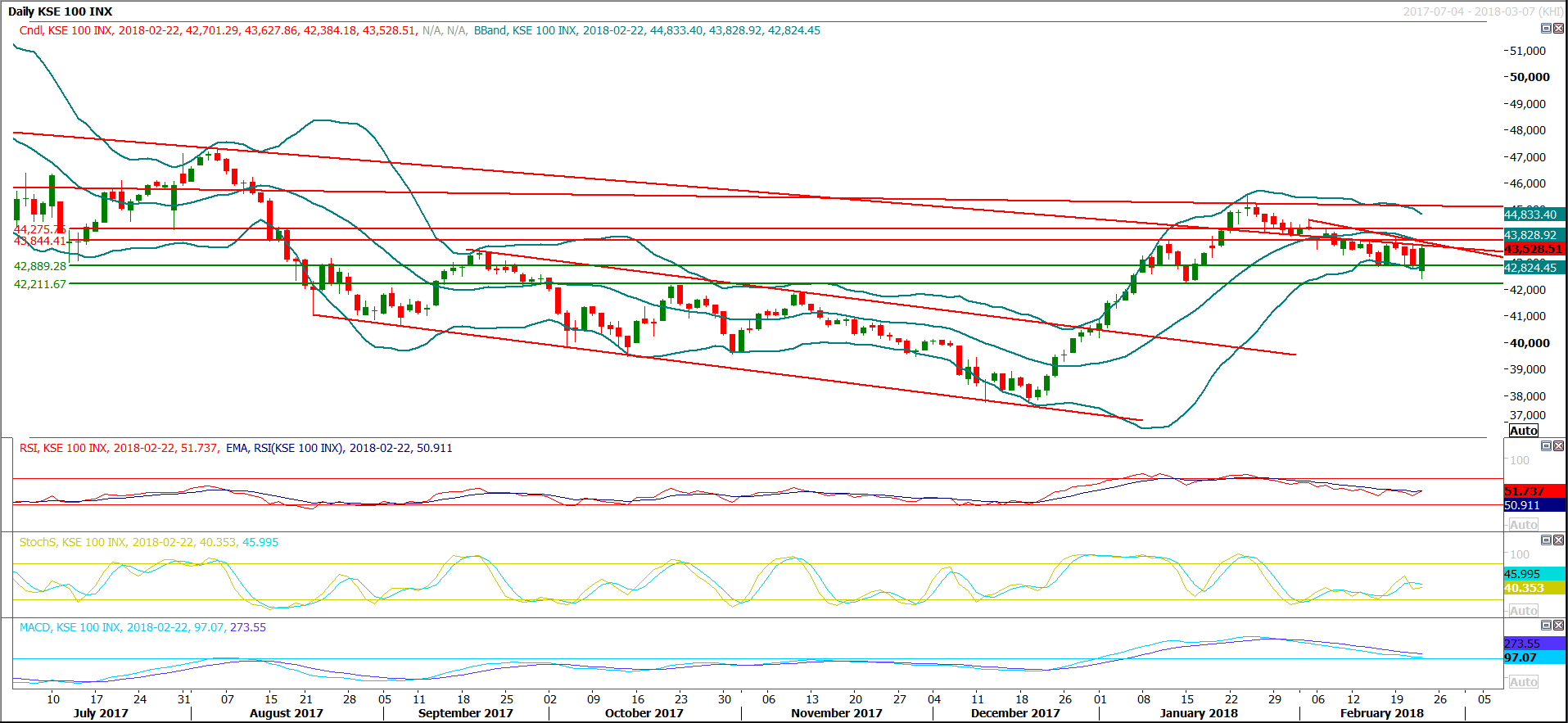Previous Session Recap
Trading volume at PSX floor increased by 2.58 million shares or 1.37% on DoD basis during last trading session, whereas the benchmark KSE100 Index opened at 42701.29, posted a day high of 43627.86 and a day low of 42384.18 during last trading session. The session suspended at 43528.51 with net change of 608.73 and net trading volume of 67.53 million shares. Daily trading volume of KSE100 listed companies dropped by 10.69 million shares or 13.66% on DoD basis.
Foreign Investors remained in net selling position of 3.53 million shares but net value of Foreign Inflow increased by 0.12 million US DOllars. Categorically, Foreign Individuals remained in net buying position of 0.08 million shares but Foreign Corporate and Overseas Pakistanis remained in net selling positions of 3.47 and 0.14 million shares. While on the other side Local Individuals remained in net selling position of 7.96 million shares but Local Companies, Mutual Funds, Brokers and Insurance Companies remained in net buying positions of 2.05, 1.61, 2.11 and 4.1 million shares respectively.
Analytical Review
Asian shares rebounded on Friday as comments from a Federal Reserve official eased worries that the central bank might raise rates more aggressively this year, while the safe-haven yen held on to its gains amid heightened volatility across markets. MSCI’s broadest index of Asia-Pacific shares outside Japan climbed 0.4 percent, but was still on track to end the week barely changed. Australian and New Zealand shares were each up 0.5 percent while Japan’s Nikkei edged 0.3 percent higher and South Korea’s KOSPI index rose 1 percent. Asian shares took a knock on Thursday after minutes of the Fed’s last meeting showed policy makers were confident about the economic outlook, prompting some investors to boost the odds of faster rate hikes. The Fed started tightening its ultra-loose policy at the end of 2015 after keeping rates on hold for almost a decade. It raised interest rates three times in 2017 and is likely to tighten again in March.
Pakistan’s oil and food import bill rose nearly 26 per cent year-on-year to $11.6 billion in the first seven months of the current fiscal year owing to an increase in global prices of crude and grains. The amount comes to slightly above one third of the total import goods import bill for the period. Two thirds of this is due to oil imports. The trade deficit is widening as the overall import bill of the country has been on the rise since the start of 2017-18. Official figures released by the Pakistan Bureau of Statistics (PBS) on Thursday showed that the petroleum imports increased 35.6pc year-on-year to $7.9bn in July-Jan.
The National Electric Power Regulatory Authority (Nepra) on Thursday ordered ex-Wapda distribution companies to refund Rs3.242 per unit to consumers for overcharging them Rs34 billion in January. The decision was taken at a public hearing presided over by Nepra Chairman Brig Tariq Sadozai on the request of Central Power Purchase Agency (CPPA). On behalf of distribution companies of ex-Wapda, the CPPA said the consumers need to be refunded Rs2.98 per unit for the fact that actual fuel cost in January amounted to Rs6.90 per unit because of lower fuel cost and favourable energy mix as against Rs9.87 per unit reference cost set by the regulator.
The foreign exchange reserves of the country fell by $139 million to $18.829bn during the week ended Feb 16, the State Bank of Pakistan (SBP) reported on Thursday. The foreign exchange reserves have been taking a toll each successive week, posing the risk they could fall below the critical level that requires the country to have forex holdings to cover at least three months’ imports. The reserves held by the SBP also dropped to $12.704bn, seeing a decline of $130m due to external debt-servicing and other official payments. The central bank’s reserves are being used to meet the widening current account deficit, which increased by 48 per cent to $9.2bn in the first seven months of this fiscal year.
The federal government has transferred Rs1093.8 billion to four provinces under the National Finance Commission award that enabled the federating units to present a surplus budget during the first half (July- December) of the current fiscal year. The centre has so far transferred 45 percent of the total estimated amount of Rs2, 384.2 billion under the federal divisible pool. In the first quarter, provinces were supposed to receive 50 percent (around Rs1192.1 billion) of the total estimated amount of Rs2, 384.2 billion, however, the government has transferred almost Rs100 billion less than the expected sum to the provinces despite healthy growth in tax collection. "It is a normal practice that the federal government transfers a lesser amount of revenue to the provinces in the first half as compared to the second half as tax collection of the Federal Board of Revenue increases during the second half of a fiscal year," said an official in the Ministry of Finance.
Market seems to remain volatile during current trading session therefore its recommended to practice caution.
Technical Analysis
The Benchmark KSE100 Index have generated a bullish engulfing pattern on daily chart during last trading session which is a strong bullish reversal pattern but index is still capped by two major resistances at 43687 and 43860 points from a descengind trend line along with a horizontal resistant region. Its expected that index would try to open with a positive gap above its resistant trend line on technical basis but would start a bearish trend before day end as hourly momentum is turning into bearish side. Its recommended to sell on strength until index close above 44560 points on daily basis.
 To Open picture in original resolution right click image and then click open image in a new tab
To Open picture in original resolution right click image and then click open image in a new tab


0 Comments
No comments yet. Be the first to comment!
Please log in to leave a comment.